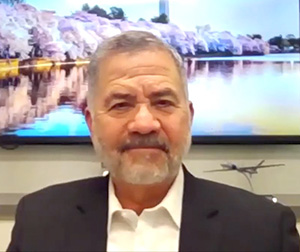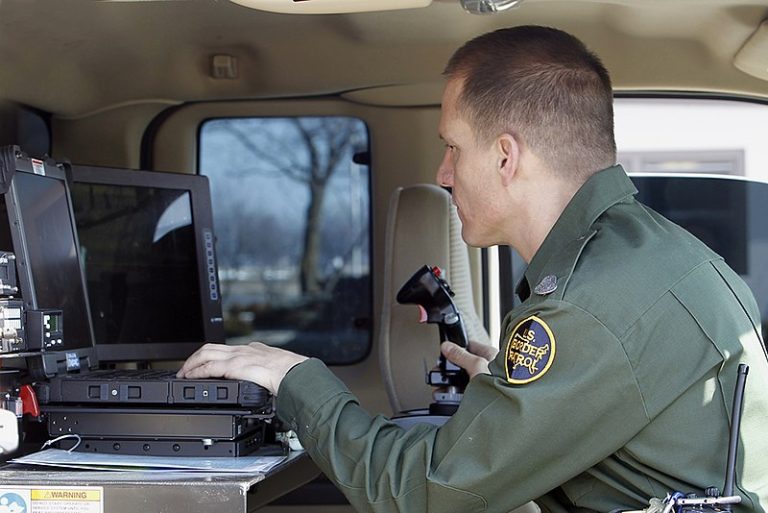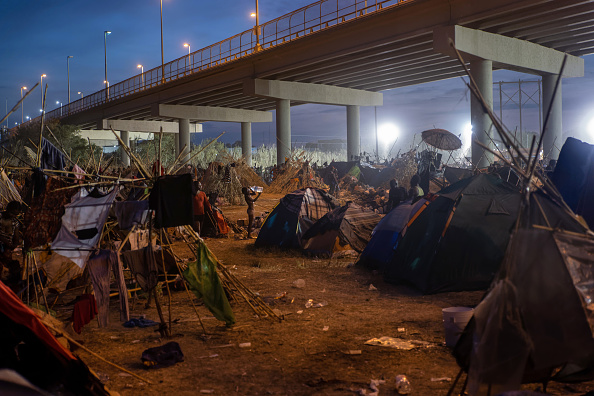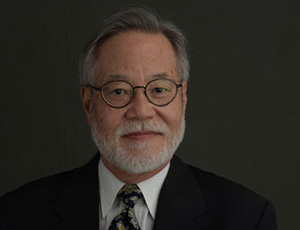Views expressed by any party interviewed by Ideaspace are those of the interviewee and are not necessarily shared by Ideaspace.

In February, Ideaspace produced a Capitol Hill Briefing with former U.S. Customs and Border Protection Commissioner David Aguilar about data-driven border security, an approach that works to anticipate global factors that drive migration and to foster international cooperation to address those migration flows.Our conversation with Aguilar occurred during the first days of the war in Ukraine and he offered a few thoughts about what that conflict might mean for global migration. At the time, Aguilar predicted that the world would see at least 5 million refugees leaving Ukraine — a number that seemed extraordinary at the time. But that prediction was realized just a few months later and now the total is approximately 7 million.
Recently, Ideaspace’s Research Director DW Gibson spoke with Aguilar again and asked him to offer an updated assessment regarding the migration outflow from Ukraine and what bearing it might have on effective immigration policy choices in the U.S.
The interview has been lightly edited for clarity.
***
Ideaspace: It’d be great to get your updated thoughts on the flow of people out of Ukraine and the region — where do you think we might end up in terms of the overall migratory numbers and what does it all mean for the U.S. immigration system?
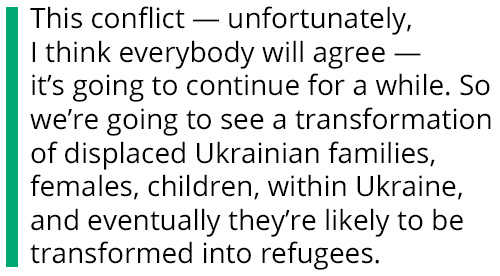 David Aguilar: Well, it’s an interesting question, because right now the number is between 6.5 and 7.2 million refugees. And they’re heading towards Poland and Germany. Those are the countries of choice right now. Obvious reasons, Poland’s proximity, friends, family linkages, and things that have been there historically. In addition to that, Germany is a very welcoming country.
David Aguilar: Well, it’s an interesting question, because right now the number is between 6.5 and 7.2 million refugees. And they’re heading towards Poland and Germany. Those are the countries of choice right now. Obvious reasons, Poland’s proximity, friends, family linkages, and things that have been there historically. In addition to that, Germany is a very welcoming country.
The rest of the migrants are spread out, but the most important number we should be looking at for that part of the world — and eventually the impact it might have on the U.S. — is the displaced numbers within Ukraine. That number is actually a little larger than the 7.2 million refugees that we’re at now. This displaced universe is composed mostly of women and children within Ukraine.
 This conflict — unfortunately, I think everybody will agree — it’s going to continue for a while. So we’re going to see a transformation of displaced Ukrainian families, females, children, within Ukraine, and eventually they’re likely to be transformed into refugees.
This conflict — unfortunately, I think everybody will agree — it’s going to continue for a while. So we’re going to see a transformation of displaced Ukrainian families, females, children, within Ukraine, and eventually they’re likely to be transformed into refugees.
How much more can Poland take, for example? It’s already asking for help from the E.U. — and receiving help. But there’s only so much that these countries, which are not large countries, can take. I think we’re going to see some of these countries get taxed in a way we haven’t seen probably since World War II. It’s going to be critical that the E.U. step up as a whole. It’s going to be critical that the U.S. continues to provide support. We’re looking at about a $43 billion aid package now, if this last round passes, but most of that, of course, is going towards weaponry, equipment and things of that nature.
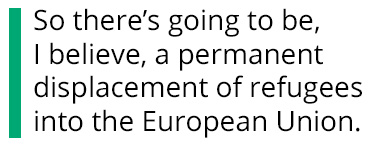 So I think attention is going to have to be placed on the rest of the E.U., as it relates to refugees that are going to continue to stream in. A lot of things have already been put into play. For example, their version of TPS [Temporary Protected Status] has been implemented within the European Union. I did a little bit of research and some of these Schengen countries are high interest points [as destination countries]. The reason for that, of course, is that migrants enter Schengen countries and then they can move wherever within the region.
So I think attention is going to have to be placed on the rest of the E.U., as it relates to refugees that are going to continue to stream in. A lot of things have already been put into play. For example, their version of TPS [Temporary Protected Status] has been implemented within the European Union. I did a little bit of research and some of these Schengen countries are high interest points [as destination countries]. The reason for that, of course, is that migrants enter Schengen countries and then they can move wherever within the region.
So there’s going to be, I believe, a permanent displacement of refugees into the European Union. That’s not necessarily a bad thing, but depending on what happens — win, lose or draw, and hopefully it’s a win on the part of Ukraine — a lot of their brain trust is going to be departing, a lot of their family units are going to be departing. These are the kinds of things that I think we need to be looking at as we progress through this situation.
Ideaspace: You mentioned a little bit of a historical context. I wonder if you might offer more thoughts on that front. You referenced World War II. How do you see the current situation in relation to other conflicts of the 20th and 21st century?
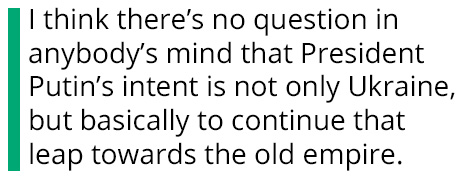 Aguilar: The most recent situations were the war in Syria, as well as the end of the war in Afghanistan, and all of that created a real bad problem for several nations. I think the war in Ukraine is going to continue to have that type of impact and the hope, of course, is that this doesn’t spread to Moldova, to some of the other areas that could potentially be targeted. That’s what will ultimately determine the historic nature of the number of refugees. I think there’s no question in anybody’s mind that President Putin’s intent is not only Ukraine, but basically to continue that leap towards the old empire. That’s something that we need to all be focused on.
Aguilar: The most recent situations were the war in Syria, as well as the end of the war in Afghanistan, and all of that created a real bad problem for several nations. I think the war in Ukraine is going to continue to have that type of impact and the hope, of course, is that this doesn’t spread to Moldova, to some of the other areas that could potentially be targeted. That’s what will ultimately determine the historic nature of the number of refugees. I think there’s no question in anybody’s mind that President Putin’s intent is not only Ukraine, but basically to continue that leap towards the old empire. That’s something that we need to all be focused on.
Under President Biden, the U.S. opened up to receive [up to] 100,000 [Ukrainian evacuees]. We’ve always been a welcoming nation. One-hundred thousand is a good size group. But we’re not really seeing a lot of Ukranians on the borders. I think the highest number we saw was back in February and March. Since then, the number has actually dropped. But of course we’re not in close proximity to that part of the world and that is a factor. As I said earlier, much of the migration has been — and will continue to be — to countries that are closer to the conflict.
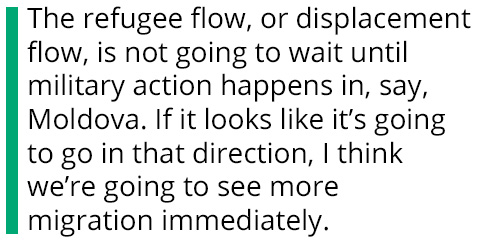
Ideaspace: Do you think there are factors other than proximity that will determine migratory movements out of Ukraine?
Aguilar: I think there’s that immediate relationship with Europe as a whole. There was a survey of 4,000 Ukranians at all the entry points into Poland and into Hungary and the reason given for selecting those locations was often some kind of familial or past relationship linkage. So it becomes a community dynamic.
Ideaspace: Returning to a point you made earlier: In terms of understanding this conflict and these migratory patterns in historical context, it sounds like you’re emphasizing that much will be determined by whether or not this conflict stays contained to Ukraine or whether it spills into other countries like Moldova. Is that a defining dynamic as you see it?
Aguilar: I would say so. The refugee flow, or displacement flow, is not going to wait until military action happens in, say, Moldova. If it looks like it’s going to go in that direction, I think we’re going to see more migration immediately because now Putin has proven the intent and the actions that followed. We all saw two and a half months, three months of preparation in Ukraine. In the U.S. we were basically saying it’s going to happen, it’s going to happen. And when it did, it was almost like there was a point of disbelief — even in Ukraine — because weeks before they were saying, “No, the intelligence is wrong. It’s not going to happen.” And then it did. So I don’t think that’s going to happen again. If it looks like it’s heading in their direction, I think that movement will start happening quickly.
Ideaspace: When we spoke earlier, we were talking about reframing “border security” as “migration management,” and emphasizing international cooperation. So with the war in Ukraine, we were hit with a major challenge in terms of seeing that international cooperation play out. It felt like in the early days, there was a lot of that cooperation and you’ve referenced how some of that remains ongoing. I’m wondering how you think this conflict has influenced this conversation about reframing “border security” in the U.S.?
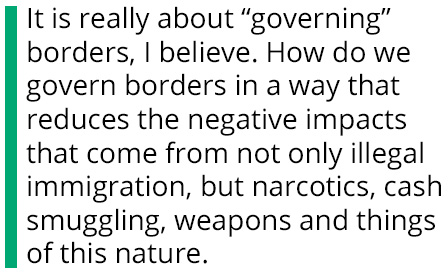
Aguilar: Well, I talked about lessons learned and I think this is an ongoing evolving lesson learned. The last time I chatted with you, we discussed defining what countries need to do with their borders. In the United States, we often talk about “sealing” them. We’ve talked about “managing” them. We’ve talked about “controlling.” We’ve talked about “governing” borders. We need to bring some better definition to what we want to do at our borders. Because right now, it’s a war in Ukraine. Is that going to happen with our partners to the north and south — Canada and Mexico? Probably not. But climate is influencing things right now that we had never thought about before. So these are actions that we need to anticipate and we need to understand what we need to do to control these borders.
And there I go using the term “control.” But is it control? Is it managing? Is it servicing? Is it governing? Also I would add that we need to think about borders more expansively. Not just our borders but Mexico, the Northern triangle, Venezuela, Brazil — the Americas. All of those. How do we jointly take a look at what needs to be done for these eventualities like conflict and climate change that are going to continue to happen?
When it comes to borders, my default — because of my background — is going to be border “control.” When I talk about immigration, especially at the levels we see now, it is being controlled by the [crime] cartels. So control is being weaponized, literally, where they manage the flow. But in a broader sense and more a collective effort, it is really about “governing” borders, I believe. How do we govern borders in a way that reduces the negative impacts that come from not only illegal immigration, but narcotics, cash smuggling, weapons and things of this nature.
Ideaspace: You mentioned climate change. The Washington Post recently reported that 1 out of 6 Americans is now in danger of having their lives disrupted by a wildfire. I wonder about the dynamics of migration within the U.S. because of some of these dynamics. We’re dealing with these issues internally. I wonder if our internal factors and dynamics can help us confront similar issues that happen on an international scale?
 Aguilar: I’m going back in my memory to President Clinton. We’re going way back in time now — there was no DHS, but there was the immigration service. There was a group of representatives from several agencies that were brought together to talk about a brand new terminology: climate change. I remember when we sat down as a group, there were people literally laughing, what are we doing here? This is not a reality. Well, fast forward to where we are today and it is becoming more of a reality literally on a daily basis.
Aguilar: I’m going back in my memory to President Clinton. We’re going way back in time now — there was no DHS, but there was the immigration service. There was a group of representatives from several agencies that were brought together to talk about a brand new terminology: climate change. I remember when we sat down as a group, there were people literally laughing, what are we doing here? This is not a reality. Well, fast forward to where we are today and it is becoming more of a reality literally on a daily basis.
So it’s important to look at these leading indicators — risk of exposure to a wildfire and so on — and understand what those mean 15, 20, 25 years down the road. Is there going to be a displacement, for example, within the United States, in certain parts of the country, because of these things that are happening? Last time we talked about the droughts. What does that mean for displacement because of the devastation to agriculture?
All of these things, these are leading indicators that we need to be taking a look at, paying attention to, and frankly, doing something about.
Read More:
